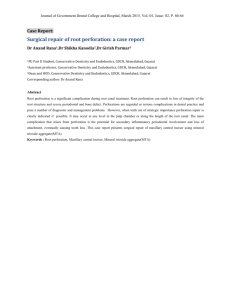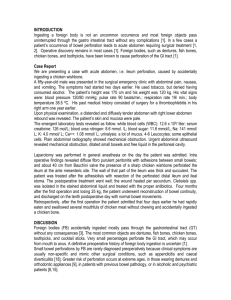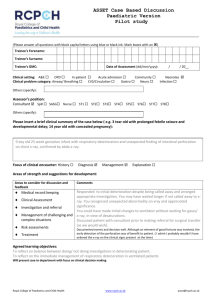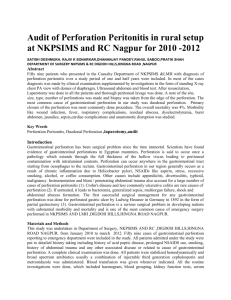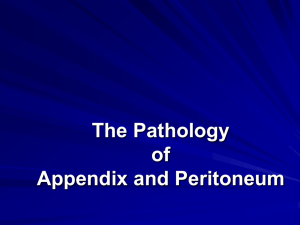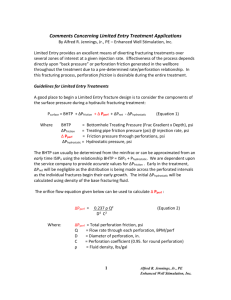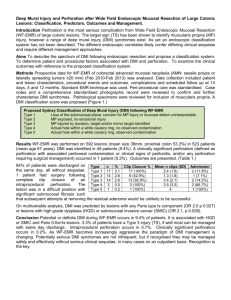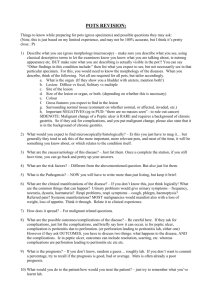a clinical study to analyse the spectrum of peritonitis due to hollow
advertisement
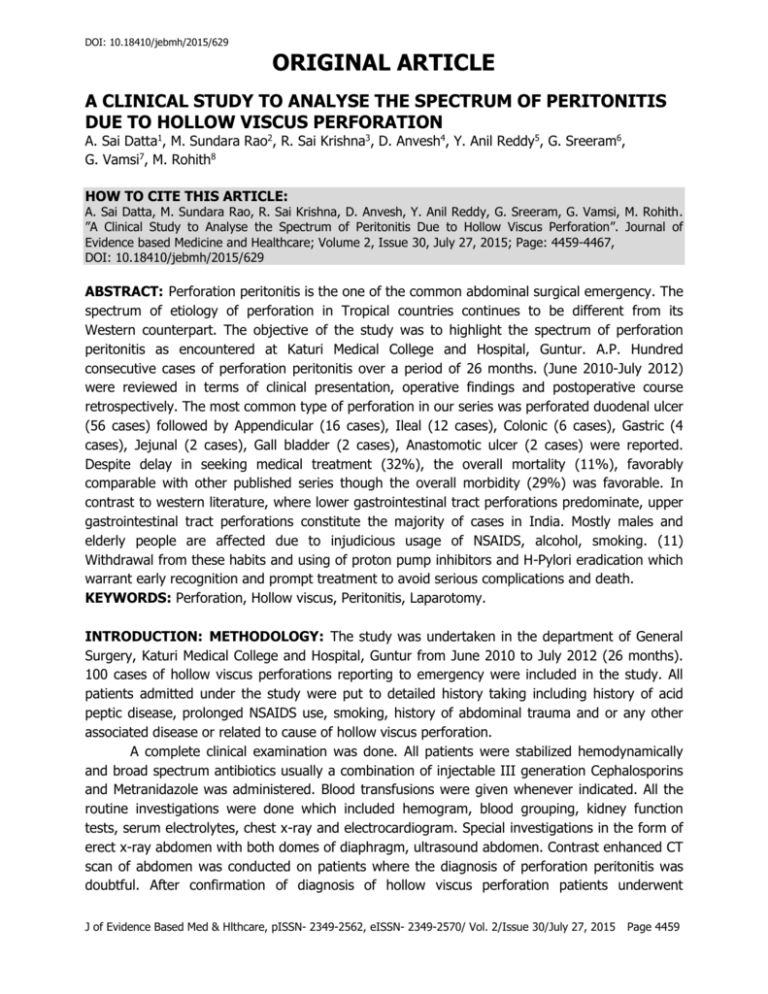
DOI: 10.18410/jebmh/2015/629 ORIGINAL ARTICLE A CLINICAL STUDY TO ANALYSE THE SPECTRUM OF PERITONITIS DUE TO HOLLOW VISCUS PERFORATION A. Sai Datta1, M. Sundara Rao2, R. Sai Krishna3, D. Anvesh4, Y. Anil Reddy5, G. Sreeram6, G. Vamsi7, M. Rohith8 HOW TO CITE THIS ARTICLE: A. Sai Datta, M. Sundara Rao, R. Sai Krishna, D. Anvesh, Y. Anil Reddy, G. Sreeram, G. Vamsi, M. Rohith. ”A Clinical Study to Analyse the Spectrum of Peritonitis Due to Hollow Viscus Perforation”. Journal of Evidence based Medicine and Healthcare; Volume 2, Issue 30, July 27, 2015; Page: 4459-4467, DOI: 10.18410/jebmh/2015/629 ABSTRACT: Perforation peritonitis is the one of the common abdominal surgical emergency. The spectrum of etiology of perforation in Tropical countries continues to be different from its Western counterpart. The objective of the study was to highlight the spectrum of perforation peritonitis as encountered at Katuri Medical College and Hospital, Guntur. A.P. Hundred consecutive cases of perforation peritonitis over a period of 26 months. (June 2010-July 2012) were reviewed in terms of clinical presentation, operative findings and postoperative course retrospectively. The most common type of perforation in our series was perforated duodenal ulcer (56 cases) followed by Appendicular (16 cases), Ileal (12 cases), Colonic (6 cases), Gastric (4 cases), Jejunal (2 cases), Gall bladder (2 cases), Anastomotic ulcer (2 cases) were reported. Despite delay in seeking medical treatment (32%), the overall mortality (11%), favorably comparable with other published series though the overall morbidity (29%) was favorable. In contrast to western literature, where lower gastrointestinal tract perforations predominate, upper gastrointestinal tract perforations constitute the majority of cases in India. Mostly males and elderly people are affected due to injudicious usage of NSAIDS, alcohol, smoking. (11) Withdrawal from these habits and using of proton pump inhibitors and H-Pylori eradication which warrant early recognition and prompt treatment to avoid serious complications and death. KEYWORDS: Perforation, Hollow viscus, Peritonitis, Laparotomy. INTRODUCTION: METHODOLOGY: The study was undertaken in the department of General Surgery, Katuri Medical College and Hospital, Guntur from June 2010 to July 2012 (26 months). 100 cases of hollow viscus perforations reporting to emergency were included in the study. All patients admitted under the study were put to detailed history taking including history of acid peptic disease, prolonged NSAIDS use, smoking, history of abdominal trauma and or any other associated disease or related to cause of hollow viscus perforation. A complete clinical examination was done. All patients were stabilized hemodynamically and broad spectrum antibiotics usually a combination of injectable III generation Cephalosporins and Metranidazole was administered. Blood transfusions were given whenever indicated. All the routine investigations were done which included hemogram, blood grouping, kidney function tests, serum electrolytes, chest x-ray and electrocardiogram. Special investigations in the form of erect x-ray abdomen with both domes of diaphragm, ultrasound abdomen. Contrast enhanced CT scan of abdomen was conducted on patients where the diagnosis of perforation peritonitis was doubtful. After confirmation of diagnosis of hollow viscus perforation patients underwent J of Evidence Based Med & Hlthcare, pISSN- 2349-2562, eISSN- 2349-2570/ Vol. 2/Issue 30/July 27, 2015 Page 4459 DOI: 10.18410/jebmh/2015/629 ORIGINAL ARTICLE emergency exploratory laparotomy through a midline incision. At the time of surgery, the source of contamination was sought for and appropriate procedure was performed. Further a note of the site of perforation, size of perforation, type of perforation, number of perforations, Amount of contamination was made. Biopsy was taken from the perforation edge whenever required. Every case was put to thorough normal saline peritoneal lavage. Two to three closed system drains were kept in every patient. All the patients were followed post-operatively by nothing per oral, nasogastric suction, intravenous fluids and antibiotic cover. Early ambulation was ensured and whenever required appropriate physiotherapy administered. In cases of moderate to severe anemia, blood transfusion was given. Complications if occurred were vigorously managed. Patients were allowed oral diet after the return of bowel sounds, passage of flatus and/or stools. The patients were followed up in surgical OPD after discharge. RESULTS AND OBSERVATION: This observational study was undertaken over a period of 26 months June 2010 to July 2012 in the Department of General Surgery, Katuri Medical College and Hospital, Guntur and 100 patients who underwent emergency laparotomy for hollow viscus perforation were included in the study. The group of patients studied appears to be a fair representative of the various demographic patterns associated with the disease. The majority of patients were in the third to sixth decade of life with the highest incidence in the fifth decade of life. The mean age in our study was 44 years. Incidence of Hollow viscus perforation (June 2010- July 2012): No. of Emergency admissions: 650. No. of hollow viscus perforations: 100(15.3%). J of Evidence Based Med & Hlthcare, pISSN- 2349-2562, eISSN- 2349-2570/ Vol. 2/Issue 30/July 27, 2015 Page 4460 DOI: 10.18410/jebmh/2015/629 ORIGINAL ARTICLE In our study (32%) cases had associated co- morbid conditions. Most common associated disease was COPD followed by hypertension, cardiac abnormalities, diabetes, and tuberculosis, deranged RFT's, malignancy. Preoperative diagnosis was mainly clinical supplemented with investigations in the form of X-ray chest showing free gas under right dome of diaphragm, ultrasound abdomen was done. CECT abdomen was rarely done in patients with trauma or in patients with diagnostic dilemma. The most common cause of hollow viscus perforation in our study was duodenal ulcer perforation (56%)[1] mainly due to acid peptic disease, NSAIDs,[2] Alcoholism, Smoking followed by appendicitis (16%) mainly due to Fecolith obstruction. In cases of duodenal perforation all the perforations were in the anterior wall of the duodenum mostly in the first part. In cases of appendicular perforation most of the perforations were in the tip (70%) and the remaining were in the body and base of the appendix. Appendicular perforations were mainly found in extremes of age most commonly at the tip, followed by distal 1/3rd and base. J of Evidence Based Med & Hlthcare, pISSN- 2349-2562, eISSN- 2349-2570/ Vol. 2/Issue 30/July 27, 2015 Page 4461 DOI: 10.18410/jebmh/2015/629 ORIGINAL ARTICLE In cases of ileal perforations 66.66% were due to typhoid,[3][1] 25% were due to tubercular and 8.33% due to non-specific inflammatory. Generally typhoid perforations occurred in the second week of fever and most of the times perforations were multiple. MORBIDITY AND MORTALITY: The most common performed procedure was primary closure of the perforation Duodenal perforation was the most common to be closed primarily with omental patch (45cases).[1][4] For (6 cases) of duodenal perforation we have done serosal patch of jejunum along with feeding jejunostomy. In (5 cases) of duodenal perforation this poor general condition were put on B/L flank drains. Second most common procedure was Appendicectomy for appendicular perforation. Third procedure performed was two layered closure & resection and anastomosis for ileum. Ileum was most common site where resection and anastomosis was done. For colonic perforation primary closure in (3 cases), Resection & anastomosis done in one case In cases where there was large amount of contamination and the general condition of the patient was very poor, exteriorization of the gut in the form of ileostomy or colostomy was done in(2 cases)[5] In 4 cases of gastric perforation simple closure with omental patch was done. For jejunal perforation, in (2 cases) resection & anastomosis done. For gallbladder perforation, in 2 cases cholecytstectomy done and for anastomatic ulcer perforation, in (2 cases) were treated with simple closure and omental patch. In all patients peritoneal lavage with warm normal saline done. The most common complication observed was wound infection which occurred in (14%) of the patients followed respiratory complications in (04%), burst abdomen in (04%), sepsis in (05%), and Dyselectrolemia in (02%) of the patients. The overall morbidity was 29%.all patients advised proton pump inhibitors and H. pylori eradication treatment.[6][7] The overall mortality observed in our study was (11%). All patients died due to Septicemia and Cadiogenic shock. postoperatively.[6] Common factors in all the deaths were late presentation, extremes of age, low preoperative hemoglobin, poor nutrition, associated malignancy, tuberculosis, poor cardiac risk patients, irreversible shock, and septicemia and associated co-morbid conditions. J of Evidence Based Med & Hlthcare, pISSN- 2349-2562, eISSN- 2349-2570/ Vol. 2/Issue 30/July 27, 2015 Page 4462 DOI: 10.18410/jebmh/2015/629 ORIGINAL ARTICLE J of Evidence Based Med & Hlthcare, pISSN- 2349-2562, eISSN- 2349-2570/ Vol. 2/Issue 30/July 27, 2015 Page 4463 DOI: 10.18410/jebmh/2015/629 ORIGINAL ARTICLE DISCUSSION: Perforation peritonitis is one of the most common surgical conditions encountered in surgical practice and is a common cause of morbidity and mortality and warrants early surgical intervention. Adequate resuscitation along with baseline investigations and broad spectrum antibiotics are imperative in each case. Anatomical, pathological, and surgical factors may favour localization of peritonitis.[6] However, in majority of the cases peritonitis becomes diffuse when it occurs in patients with sudden anatomical disruption, extremes of age, immunodeficiency, stimulation of peristalsis and following trauma.[3] The clinical presentation of the patients depends upon the site of perforation. Patients of duodenal perforation present with a short history of pain epigastrium or upper abdomen along with generalized tenderness and guarding. In patients of diverticulitis patients are generally of old age and past history of constipation is present along with signs of peritonitis. Appendicular perforations have a characteristic pain starting in periumblical area or right iliac fossa along with vomiting and fever. There are also conspicuous signs present like guarding and rebound tenderness in right iliac fossa. Ileal perforations are usually preceded by a history of some medical disease followed by sudden onset of lower abdomen pain, vomiting, abdominal guarding and distention later on toxicity with septic shock. In patients of trauma generalized peritoneal signs start developing after 2-3 hours of injury.[3] Most common symptom at presentation was pain followed by vomiting, abdominal distention, fever and constipation.[8] In our study we found that patients who presented early after perforation and had no associated co-morbid conditions behaved very well in the postoperative period. In patients with very poor general condition and irreversible shock, drains were put under local anaesthesia and adequate resuscitation along with antibiotic cover, blood transfusion was given to the patients and were taken up for laparotomy after their general condition improved. External drainage of the peritoneal cavity was made mandatory in every case by means of closed drainage system. The major complications which occurred following surgery included wound infection, fever, respiratory complications,, burst abdomen, dyselectrolemia,[6][7] jaundice, sepsis, cardiac complications, and anastomotic disruption which are known risk factors for high mortality. The overall mortality was 11%.Although there is a paucity of data on the overall spectrum of peritonitis few studies that we were able to identify commonly implicated perforations of the duodenum as the commonest cause of peritonitis in this study. CONCLUSION: 1. The most common age group affected is 40-50 years and above. 2. Duodenal ulcer perforations were more in the age group of 40-50 years and above. 3. Most of the patients presented with clinical signs of peritonitis within 24 hours (68%). 4. 82% were male patients and 18% were female patients. 5. Duodenum was the most common site (56%) followed by Appendicular (16%), Ileal (12%), Colon (06%), Gastric (04%), Jejunal (02%), Gall Bladder 6. (02%) and Anastomotic ulcer perforation (02%). 7. Guarding and Rigidity were present in 90% of patients. J of Evidence Based Med & Hlthcare, pISSN- 2349-2562, eISSN- 2349-2570/ Vol. 2/Issue 30/July 27, 2015 Page 4464 DOI: 10.18410/jebmh/2015/629 ORIGINAL ARTICLE 8. Diagnosis was made clinically and confirmed by the presence of pneumoperitoneum on radiographs, ultrasonogram abdomen and CT scan abdomen if required. 9. Laparotomy with simple closure of the perforation with omental patch is the commonest operative management of perforated ulcer (63%). 10. The most common post-operative complication was wound infection (14%). 11. The overall mortality rate was 11%. 12. Prevention of Gastroduodenal ulcer perforation can be accomplished in most of the cases by early diagnosis and treatment of underlying precipitating conditions by using proton pump inhibitors and H-Pylori eradication. J of Evidence Based Med & Hlthcare, pISSN- 2349-2562, eISSN- 2349-2570/ Vol. 2/Issue 30/July 27, 2015 Page 4465 DOI: 10.18410/jebmh/2015/629 ORIGINAL ARTICLE BIBLIOGRAPHY: 1. Soll AH. Pathogenesis of peptic ulcer and implications for therapy. N Engl, J Med 1990; 322; 909-16. 2. Fries JF, Miller SR, Spitz PW Toward an epidemiology of gastropathy associated with nonsteroidal anti-inflammatory drug use. Gastroenterology 1989; 96: 647-55. 3. Kapoor MR, Nair D, Chintamani MS, Khanna J, Aggarwal P, Bhatnagar D. Role of enteric fever in ileal perforations; An over stated problem in tropics? Indian Journal of Medical Microbiology 2008; 26(1): 54-7. 4. David W Mercer, Emily K Robinson. Stomach. 18th ed. Chapter 47. In: Sabiston Textbook of surgery, Townsend, Beauchamp, Evers Mattox, eds. Philadelphia: Saunders Elsevier; 2008. 2: 1236. 5. Stanley W,A Schley MD, Edward E.WHANS; Small Intestine in Schwarts principles of Surgery -9th edition New York, Mc Graw Hill Medical Publishing Division 2010-p. 9791012. 6. Farthman EH, Schoffel U. Principles and limitation of operative management of intraabdominal infection. World J Surg 1990: 14: 210. 7. Last M. Kurtz L. Skin TA, Effect of PEEP on the rate of thoracic duct lymph flow and clearance of bacteria from the peritoneal cavity Am J.Surg. 1983; 145: 126. J of Evidence Based Med & Hlthcare, pISSN- 2349-2562, eISSN- 2349-2570/ Vol. 2/Issue 30/July 27, 2015 Page 4466 DOI: 10.18410/jebmh/2015/629 ORIGINAL ARTICLE 8. John Maa, MD, Kimberly S.Kirk wood, MD- The Appendix in Sabiston Text Book of Surgery18 th Edition Townsend, 2009, Volume 2 18 th edition Townsend, 2009, Volume 2,Pages 1333 – 1345. AUTHORS: 1. A. Sai Datta 2. M. Sundara Rao 3. R. Sai Krishna 4. D. Anvesh 5. Y. Anil Reddy 6. G. Sreeram 7. G. Vamsi 8. M. Rohith PARTICULARS OF CONTRIBUTORS: 1. Associate Professor, Department of General Surgery, Katuri Medical College & Hospital, Guntur. 2. Professor, Department of General Surgery, Katuri Medical College & Hospital, Guntur. 3. Assistant Professor, Department of General Surgery, Katuri Medical College & Hospital, Guntur. 4. Post Graduate, Department of General Surgery, Katuri Medical College & Hospital, Guntur. 5. Post Graduate, Department of General Surgery, Katuri Medical College & Hospital, Guntur. 6. Post Graduate, Department of General Surgery, Katuri Medical College & Hospital, Guntur. 7. Post Graduate, Department of General Surgery, Katuri Medical College & Hospital, Guntur. 8. Post Graduate, Department of General Surgery, Katuri Medical College & Hospital, Guntur. NAME ADDRESS EMAIL ID OF THE CORRESPONDING AUTHOR: Dr. A. Sai Datta, Flat No. 9, Teja Apartment, 4/13, Brodiepet, Guntur-522002. E-mail: doctordattu78@gmail.com Date Date Date Date of of of of Submission: 20/07/2015. Peer Review: 21/07/2015. Acceptance: 24/07/2015. Publishing: 27/07/2015. J of Evidence Based Med & Hlthcare, pISSN- 2349-2562, eISSN- 2349-2570/ Vol. 2/Issue 30/July 27, 2015 Page 4467
